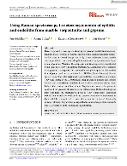Using Raman spectroscopy to detect scytonemin of epiliths and endoliths from marble, serpentinite and gypsum

Datum vydání
2023Publikováno v
Journal of Raman SpectroscopyRočník / Číslo vydání
54 (11)ISBN / ISSN
ISSN: 0377-0486Metadata
Zobrazit celý záznamKolekce
Tato publikace má vydavatelskou verzi s DOI 10.1002/jrs.6514
Abstrakt
Here, we present Raman spectra showing the presence and distribution of scytonemin and carotenoids in epilithic and endolithic colonisations from temperate locations in Central Europe and Sicily. In the Bohemian Massif, marble and serpentinitic cyanobacterial epiliths dominated by cyanobacteria Scytonema, Stigonema, Hassallia, Gloeocapsopsis and Gloeocapsa were investigated using light microscopy and Raman spectroscopy. Scytonemin was a common dark pigment, accompanied by carotenoids and gloeocapsin on the marbles from Opolenec and on serpentinites from Holubov (South Bohemia). Raman spectra from other sites originated from endolithic colonisations of gypsum. They were located in the Carpathian foredeep (Badenian, Silesian unit, eastern Poland) and in Messinian complexes in the Mediterranean area (Sicily). Similarly to the previous localities, almost ubiquitous occurrence of scytonemin confirmed the presence of cyanobacterial colonisations. Obtained findings are important from the spectroscopic point of view. Additionally, comparing results from several sites confirmed the common occurrence of scytonemin in both endoliths and epiliths from areas that cannot be considered climatically extreme, although they experience rapid fluctuations in temperature, humidity and UV irradiation on the exposed rocky substrates.
Klíčová slova
cyanobacteria, endolithic colonisations, epilithic colonisations, Raman spectra, scytonemin
Trvalý odkaz
https://hdl.handle.net/20.500.14178/2399Licence
Licence pro užití plného textu výsledku: Creative Commons Uveďte původ 4.0 International






